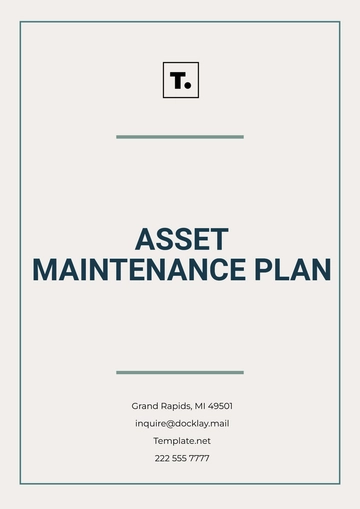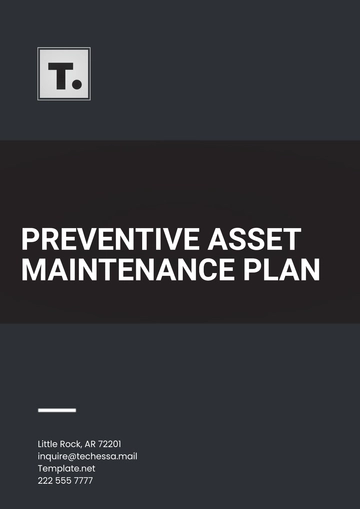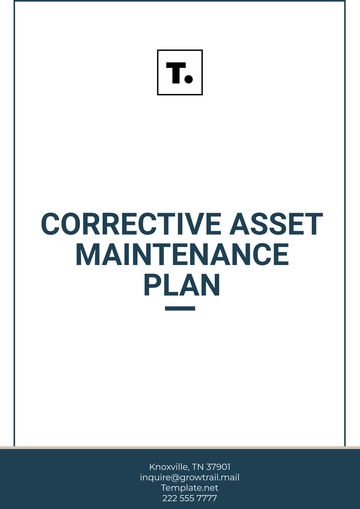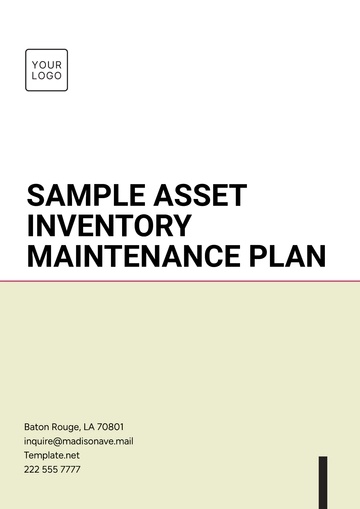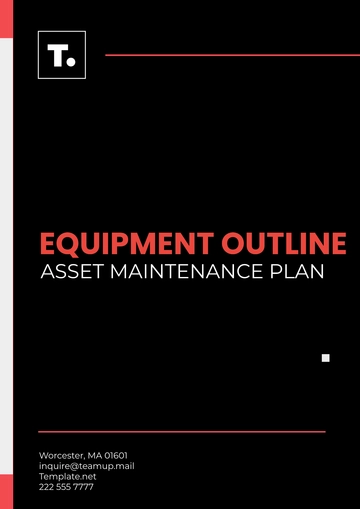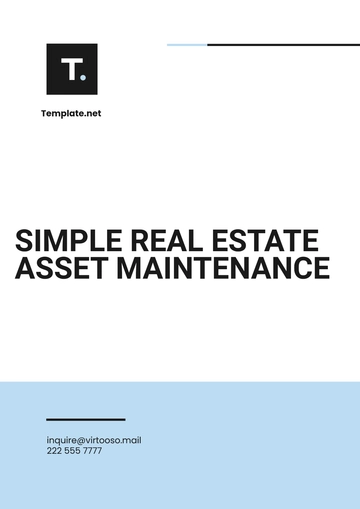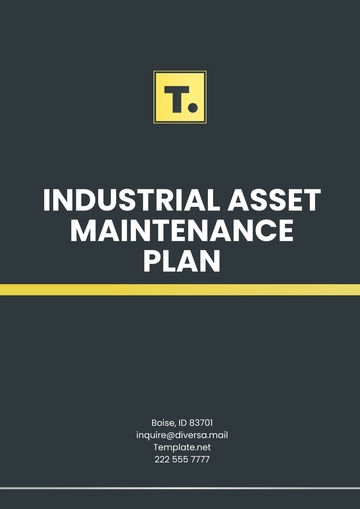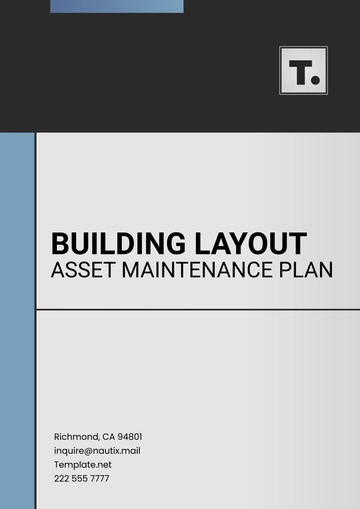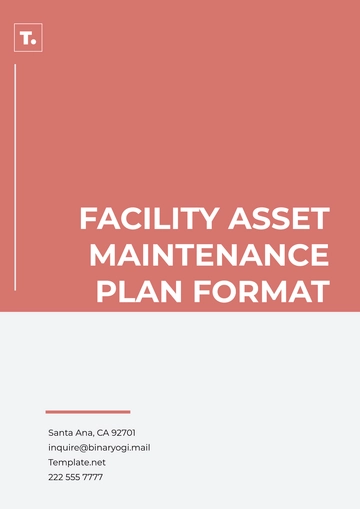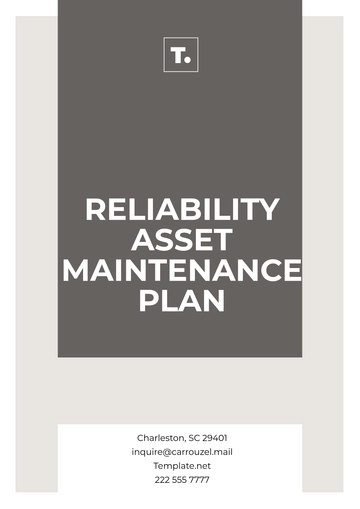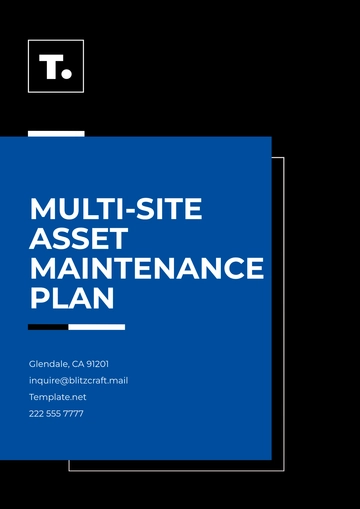Free Automotive Design Asset Maintenance Plan

Prepared by: [Your Name]
Company: [Your Company Name]
Date: [Date]
I. Introduction
The purpose of this maintenance plan is to establish clear guidelines and protocols for the upkeep of all automotive design assets, including digital models, CAD files, prototype equipment, and other critical resources. Effective maintenance will minimize downtime, enhance asset performance, and support ongoing innovation in automotive design.
A. Objectives
Ensure the integrity and accessibility of all design assets.
Maintain up-to-date records for compliance and operational efficiency.
Reduce unexpected costs and maximize the lifespan of assets.
B. Scope
This plan covers all design assets used by the Design and Engineering Department at our organization, including software, digital files, and physical prototypes.
II. Asset Inventory
This section provides a detailed list of all design assets to be maintained.
A. Asset Categories
Digital Assets: CAD files, 3D models, simulation data.
Software: Design tools (e.g., AutoCAD, SolidWorks), licenses.
Hardware: Computers, servers, prototype testing equipment.
Physical Prototypes: Model cars, component mock-ups.
B. Asset Details
ID Number: Unique identifier for each asset.
Asset Description: Brief description of the asset and its use.
Location: Where the asset is stored or used (digital or physical).
Condition: Current status of the asset (e.g., new, used, needs repair).
III. Maintenance Schedule
A regular maintenance schedule ensures that all assets remain functional and up to date.
A. Preventive Maintenance
Frequency: Monthly, quarterly, or annually based on the asset type.
Tasks: Software updates, hardware inspections, data backups.
Responsible Team: IT Department for digital assets, Engineering Team for physical assets.
B. Corrective Maintenance
Trigger: When an issue is identified, such as software malfunction or hardware failure.
Action Plan: Immediate troubleshooting, repairs, or replacement as necessary.
IV. Roles and Responsibilities
Clear definitions of responsibilities are crucial for effective maintenance.
A. Design Engineer
Primary Role: Identifies issues with design assets during use.
Responsibilities: Report defects, and provide feedback on asset performance.
B. IT Specialist
Primary Role: Manages digital asset maintenance.
Responsibilities: Software updates, data backups, license management.
C. Asset Manager
Primary Role: Oversees overall asset lifecycle management.
Responsibilities: Coordinates maintenance activities, and ensures compliance with the plan.
D. Maintenance Team
Primary Role: Conducts routine inspections and repairs.
Responsibilities: Execute scheduled tasks, and document maintenance actions.
V. Maintenance Procedures
This section outlines the specific steps for maintaining different types of design assets.
A. Digital Assets
Software Updates: Regularly check for and apply updates to design software.
File Integrity Check: Run periodic checks to detect file corruption or errors.
Data Backup: Perform backups of all digital assets monthly.
B. Hardware Assets
Inspection: Conduct visual inspections for wear and damage.
Calibration: Regularly calibrate prototype testing equipment to ensure accuracy.
Repair: Address any identified issues promptly to avoid extended downtime.
VI. Risk Management
Effective risk management minimizes the impact of unexpected issues on asset maintenance.
A. Risk Identification
Software Risks: Data loss, software bugs, expired licenses.
Hardware Risks: Equipment failure, physical damage, wear and tear.
Data Security Risks: Unauthorized access, cyberattacks.
B. Mitigation Strategies
Redundancy: Keep backup copies of critical digital assets.
Regular Audits: Conduct quarterly audits to assess asset condition.
Security Protocols: Implement firewalls and encryption for digital assets.
VII. Documentation and Recordkeeping
Accurate recordkeeping ensures compliance and aids in tracking asset history.
A. Maintenance Logs
Purpose: Record all maintenance activities for each asset.
Details: Date, task performed, responsible person, asset condition.
B. Asset History
Purpose: Maintain a complete history of each asset’s lifecycle.
Details: Acquisition date, updates, repairs, replacements.
VIII. Review and Update Protocol
Regular reviews keep the maintenance plan relevant and effective.
A. Review Frequency
Quarterly Review: Assess the effectiveness of the maintenance plan every three months.
Annual Review: Comprehensive review and update of the entire plan annually.
B. Update Process
Feedback Collection: Gather input from the Design, IT, and Maintenance teams.
Plan Revision: Make necessary updates based on feedback and new industry standards.
Approval: Obtain approval from the Asset Manager before implementing changes.
- 100% Customizable, free editor
- Access 1 Million+ Templates, photo’s & graphics
- Download or share as a template
- Click and replace photos, graphics, text, backgrounds
- Resize, crop, AI write & more
- Access advanced editor
Keep your automotive assets in peak condition with our Automotive Design Asset Maintenance Plan Template from Template.net. This customizable and editable template caters specifically to automotive maintenance needs. Editable in our Ai Editor Tool, it’s an ideal solution for organizing upkeep tasks, from design prototypes to fleet vehicles, ensuring reliable performance and streamlined maintenance planning.
You may also like
- Finance Plan
- Construction Plan
- Sales Plan
- Development Plan
- Career Plan
- Budget Plan
- HR Plan
- Education Plan
- Transition Plan
- Work Plan
- Training Plan
- Communication Plan
- Operation Plan
- Health And Safety Plan
- Strategy Plan
- Professional Development Plan
- Advertising Plan
- Risk Management Plan
- Restaurant Plan
- School Plan
- Nursing Home Patient Care Plan
- Nursing Care Plan
- Plan Event
- Startup Plan
- Social Media Plan
- Staffing Plan
- Annual Plan
- Content Plan
- Payment Plan
- Implementation Plan
- Hotel Plan
- Workout Plan
- Accounting Plan
- Campaign Plan
- Essay Plan
- 30 60 90 Day Plan
- Research Plan
- Recruitment Plan
- 90 Day Plan
- Quarterly Plan
- Emergency Plan
- 5 Year Plan
- Gym Plan
- Personal Plan
- IT and Software Plan
- Treatment Plan
- Real Estate Plan
- Law Firm Plan
- Healthcare Plan
- Improvement Plan
- Media Plan
- 5 Year Business Plan
- Learning Plan
- Marketing Campaign Plan
- Travel Agency Plan
- Cleaning Services Plan
- Interior Design Plan
- Performance Plan
- PR Plan
- Birth Plan
- Life Plan
- SEO Plan
- Disaster Recovery Plan
- Continuity Plan
- Launch Plan
- Legal Plan
- Behavior Plan
- Performance Improvement Plan
- Salon Plan
- Security Plan
- Security Management Plan
- Employee Development Plan
- Quality Plan
- Service Improvement Plan
- Growth Plan
- Incident Response Plan
- Basketball Plan
- Emergency Action Plan
- Product Launch Plan
- Spa Plan
- Employee Training Plan
- Data Analysis Plan
- Employee Action Plan
- Territory Plan
- Audit Plan
- Classroom Plan
- Activity Plan
- Parenting Plan
- Care Plan
- Project Execution Plan
- Exercise Plan
- Internship Plan
- Software Development Plan
- Continuous Improvement Plan
- Leave Plan
- 90 Day Sales Plan
- Advertising Agency Plan
- Employee Transition Plan
- Smart Action Plan
- Workplace Safety Plan
- Behavior Change Plan
- Contingency Plan
- Continuity of Operations Plan
- Health Plan
- Quality Control Plan
- Self Plan
- Sports Development Plan
- Change Management Plan
- Ecommerce Plan
- Personal Financial Plan
- Process Improvement Plan
- 30-60-90 Day Sales Plan
- Crisis Management Plan
- Engagement Plan
- Execution Plan
- Pandemic Plan
- Quality Assurance Plan
- Service Continuity Plan
- Agile Project Plan
- Fundraising Plan
- Job Transition Plan
- Asset Maintenance Plan
- Maintenance Plan
- Software Test Plan
- Staff Training and Development Plan
- 3 Year Plan
- Brand Activation Plan
- Release Plan
- Resource Plan
- Risk Mitigation Plan
- Teacher Plan
- 30 60 90 Day Plan for New Manager
- Food Safety Plan
- Food Truck Plan
- Hiring Plan
- Quality Management Plan
- Wellness Plan
- Behavior Intervention Plan
- Bonus Plan
- Investment Plan
- Maternity Leave Plan
- Pandemic Response Plan
- Succession Planning
- Coaching Plan
- Configuration Management Plan
- Remote Work Plan
- Self Care Plan
- Teaching Plan
- 100-Day Plan
- HACCP Plan
- Student Plan
- Sustainability Plan
- 30 60 90 Day Plan for Interview
- Access Plan
- Site Specific Safety Plan
